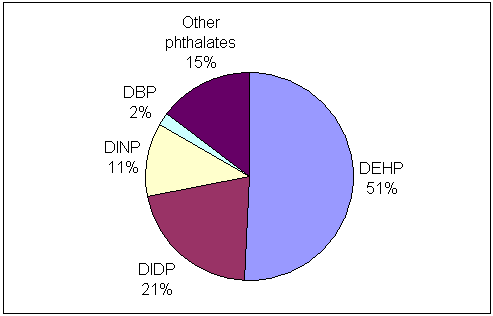


Phthalates are plasticisers that are added to other materials to make them softer and more flexible.
They are widely used in a range of polymers such as PVC that are found in a wide variety of consumer products including floor- and wall covering, furnishing, toys, car interior, clothing, hoses etc. Phthalates are also added to paints and lacquers, adhesives and sealants, printing inks etc.
Because phthalates are not chemically bound to the material they are added to, they can be released from the products that contain them, for instance into water and air. The emission of phthalates occurs during all the stages of the life cycle of a product from production, through use, to disposal. There is public concern about phthalates because of their widespread use and occurrence in the environment as well as their potential effects on human health.
A range of different phthalates exist, which each have specific properties, applications, and potential health effects.
Table: Some examples of phthalates and their applications
Five of the most widely used phthalates are di-(2-ethylhexyl) phthalate (DEHP), dibutyl phthalate (DBP), di-isononyl phthalate (DINP), di-isodecyl phthalate (DIDP) and benzyl butyl phthalate (BBP). These phthalates have been assessed within an EU program on Risk Assessment for new and existing chemical substances.
By 2004, the final reports on DBP, DIDP and DINP had been published. The content of these reports was summarised by GreenFacts.
In Europe, between 1990 and 1995, the average annual consumption of plasticisers was 970 000 tonnes, of which 894 000 tonnes were phthalates. For comparison, the worldwide plasticiser consumption is estimated at 3.5 million tonnes.
Approximation of the relative importance of the consumption of four of the main phthalates in the European Union in the 1990s

These phthalates are used mainly as plasticisers in PVC products. The total amount of these phthalates produced for use in PVC in Western Europe was 877 000 tonnes in 1994, of which 191 000 tonnes was DIDP, 101 500 tonnes was DINP, and around 18 000 tonnes was DBP.
GreenFacts comment:
It should be noted that in 2008 the EU Risk Assessments on the most commonly used phthalate, DEHP (51% in the 1990s), and on BBP have been released.
The Risk Assessment Reports (not yet summarised by GreenFacts) are available on the website of the European Chemicals Bureau:

This summary is free and ad-free, as is all of our content. You can help us remain free and independant as well as to develop new ways to communicate science by becoming a Patron!